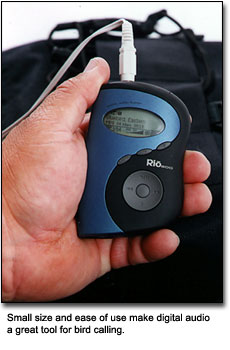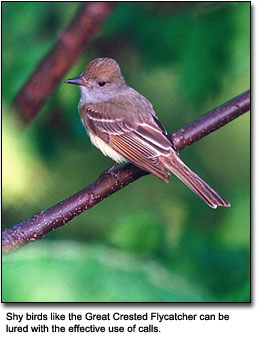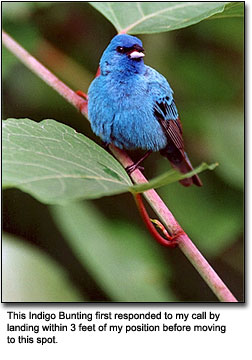|
|

All rights reserved.
Methods and Machinery Some who use calling are able to create the calls with their voice or whistle. For those of us who cannot, electronic recordings in the form of tapes or CD's are the tool of choice. Each of these has shortcomings. Tapes and the players necessary to generate an adequate sound level to be effective can be bulky. Recording multiple calls on a tape means that you must first find the call on the tape, and you will probably have to rewind and repeat the play of the call, a distraction that could cost you a shot. Recording just a single call on a tape requires carrying multiple tapes into the field unless you are targeting only one species. Compact discs, while a little more convenient with regard to finding and playing a specific call, are limited to prerecorded calls with no ability to edit them to your specific needs. CD's are also a little more fragile. A single scratch can ruin an expensive CD. Not a good attribute for a device used in the field. Calling the Digital Way Digital audio is the process of recording information for playback on digital devices. These devices include PCs, CD players or devices known as Digital Audio Players. The digital audio player is the tool we are interested in. A digital audio player is essentially a housing for a memory chip on which the recording is stored. They are available in a number of sizes; 16mb, 32mb, and 64mb are common sizes. The size of the memory is the determining factor in how much music the player can store. A rule of thumb is that 1 minute of CD quality music will occupy 1mb on the player. Digital audio players are available in a number of configurations, but most are quite small (smaller than a deck of cards), are solid state (no moving parts) and run very efficiently with one or two AA batteries, providing many hours of playback time. By using a computer to copy files (known in digital audio as "tracks") from another recorded source, like a CD, or downloading files from the Internet, we can then transfer these files to a digital audio player and replay them. When combined with a powered speaker, these players make great calling devices. Preparing for the Field
Because of the repetitive nature of most calls, and the fact that memory space on our player is valuable, I typically record only a 10-20 second segment of the call. By using the "repeat track" function on the player this small segment can loop indefinitely and uses only a small amount of memory. In addition to limiting the length of the calls, recording at a lower sampling rate can make your memory go farther. The 1-mb per 1-minute rule of thumb quoted earlier assumes that you require CD quality recordings. Since most birds are not audiophiles, I have found that a recording rate that equates to FM radio (64 kilobytes per second) is more than sufficient and really stretches the memory. To date I have the calls of 75 birds on my player and have used just 8mb of the space. At this rate, the capacity of my digital audio player should be well over 250 birds! Because the digital audio player is designed for use with headphones, in order to use it as a calling mechanism we must add a speaker. I have found that the same battery powered speakers designed for use on desktop computer systems are perfect. They come in a variety of sizes and shapes, and only one will be needed. Find one that will fit in your camera bag, and that uses the same AA batteries as your flash units, camera body and power drive booster. This will allow you to carry one type of battery and save space in your camera bag. In the Field Most of the players have a LCD screen that provides information about the tracks, name, duration, file type, etc. I load the calls in alphabetical order by family type (i.e., Woodpecker, Downy) in order to make finding a specific call easy. I simply scroll through the list on the screen and select the call I would like to play, check that the repeat track function in on and let it rip! The call will repeat without any supervision until I stop it.
What, Where and How Much Digital audio players have quite a range of prices and like most things the price is directly linked to abilities. The memory size is the single largest factor in price. The good news is that for our purposes, we do not need a great deal of memory. As mentioned earlier, 32mb is enough storage for over 250 calls. That should cover most of our needs easily. In fact a 16mb unit would be an inexpensive and quite usable device. Prices for 16mb units are dropping fast and can be found for less than $100. If you are an Ebay shopper, $50 units are out there. Higher capacity 32mb units are a little more, but I bought mine used on Ebay for $70. A set of speakers suitable for this purpose can be purchased from many sources, a local Radio Shack store supplied mine. Intended for computer use, AA powered, with 1 watt of output power, all for $20 on sale. I already owned the CD's I ripped the calls from, but even if you didn't want to purchase any, there are many sources of bird calls available for free on the Internet. As with all things, please limit your use of these calls to copyright legal uses only. Conclusion The advantages of the system are many. Small size, instant access to calls, no finding and rewinding, efficient battery use, and customizable calls are just a few. I have found it to be a joy to use compared to other systems I have tried. If you use calls, you owe it to yourself to consider digital audio players as your method. I did, and have never looked back. About the images… Digital Audio Player - Canon EOS 3, Canon 28-105, Studio Strobes, Manual Mode 1/80 at f8 on Fuji Superia 100 Great Crested Flycatcher - Canon EOS 3, Canon 300mm with 2x II converter, filled at -1.3 EV (flash reduction ON), from a window mount. 1/125th at 5.6 on Agfa HDC 100. Taken in a wood lot near Independence, Iowa. Indigo Bunting - Canon EOS 3, Canon 300mm 2.8 w/ 2x II converter, Filled at -1.3 EV (flash reduction ON) with Better Beamer. 1/160th at 5.6 on Agfa HDC 200 from a window mount. Taken in a wood lot near Independence, Iowa. Rod Nabholz - NPN 137 Editor's Note - You can view more of Rod's work in his Wild Side of Iowa Gallery. Comments on this article? Send them to the editor. |
|
|
 Many bird photographers know that the use of calls can improve the opportunities they have to make better images. Species-specific calls can help bring in a certain "target" bird, while the use of screech owl calls can stir up a flurry of activity. Both methods can bring the birds in closer for more pleasing images.
Many bird photographers know that the use of calls can improve the opportunities they have to make better images. Species-specific calls can help bring in a certain "target" bird, while the use of screech owl calls can stir up a flurry of activity. Both methods can bring the birds in closer for more pleasing images. First, we need a source of calls to digitally record. Many companies offer CD's with bird songs and calls, making them an ideal source. Additionally, many sites on the Internet offer recorded bird songs and calls as well. Extracting the call from a CD is known as "ripping". Using software that comes with the player, or from many shareware sources, we rip the call from the CD and create a track.
First, we need a source of calls to digitally record. Many companies offer CD's with bird songs and calls, making them an ideal source. Additionally, many sites on the Internet offer recorded bird songs and calls as well. Extracting the call from a CD is known as "ripping". Using software that comes with the player, or from many shareware sources, we rip the call from the CD and create a track. Depending on your approach to calling or particular mission for the day, you can load the calls on your player in different ways. My method is to have all the calls with me at all times and select a single call for play as desired. However, it is possible to create a "play list" that might include any number of calls that would then play in succession. Perhaps you have no specific target but there are 3 or 4 birds you know to frequent an area. By making a play list of their calls (remember each call is only 20-30 seconds long) and repeating the list, you can attempt to call all of these birds at once instead of being limited to just one at a time.
Depending on your approach to calling or particular mission for the day, you can load the calls on your player in different ways. My method is to have all the calls with me at all times and select a single call for play as desired. However, it is possible to create a "play list" that might include any number of calls that would then play in succession. Perhaps you have no specific target but there are 3 or 4 birds you know to frequent an area. By making a play list of their calls (remember each call is only 20-30 seconds long) and repeating the list, you can attempt to call all of these birds at once instead of being limited to just one at a time.